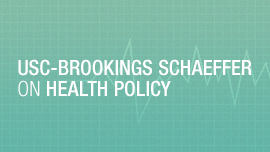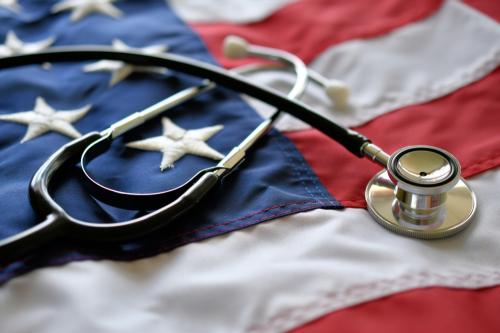This analysis is part of the USC-Brookings Schaeffer Initiative for Health Policy, which is a partnership between Economic Studies at Brookings and the University of Southern California Schaeffer Center for Health Policy & Economics. The Initiative aims to inform the national health care debate with rigorous, evidence-based analysis leading to practical recommendations using the collaborative strengths of USC and Brookings. We gratefully acknowledge financial support from The Commonwealth Fund.
Introduction
There is a great deal of controversy and uncertainty regarding profits in the Medicare Advantage (MA) program. Interest in these issues is growing as the share of beneficiaries grows. The Medicare Payment Advisory Commission, or MedPAC, recently reported that MA enrollment grew 10% from July 2020 to July 2021. This means MA accounted for 46% of all Medicare beneficiaries in 2021, with payments to MA plans totaling $350 billion. A recent visible exchange of facts and interpretations of some data by Berwick and Gilfillan, Halvorson, Crane, and Ginsburg and Lieberman has highlighted how incomplete existing data are and how that limits the ability to arrive at conclusions about market performance. The debate is focused on whether MA plans are “overpaid” and the degree to which current regulatory arrangements are likely to constrain potential overpayments. The concern is that MedPAC reports that MA plans continue to be paid 104% of traditional Medicare Fee for Service (FFS) costs, and payment benchmarks remain at 108% of traditional Medicare FFS spending. Since 2010 and the enactment of the Affordable Care Act (ACA), Medicare Part C or MA policy has aimed to improve alignment of plan costs and payments, in part by requiring that health plans in MA attain a Medical Loss Ratio (the share of premiums spent on medical care) of 0.85.[1] The ACA also reduced some payments to MA plans. Together these policy changes sought to reduce overpayments that had been previously documented. At the time, the Congressional Budget Office (CBO) and the Medicare actuary predicted large scale exit from MA markets. The actual experience has been quite different with strong market entry, and Security Exchange Commission (SEC) filings and earnings reports suggest that MA was the source of earnings growth for several large insurers (e.g., UnitedHealthcare, Humana). MA is now projected to enroll 50% of Medicare beneficiaries by 2025 or sooner.
The MA payment structure allows for several ways for plans to earn profits. MA plans are paid based on annual premium bids made against a market benchmark that is set administratively by the Centers for Medicare and Medicaid Services (CMS) under statutory authority and depends in part on the quality rating achieved by a plan. That bid serves to establish plan revenues. The difference between those revenues and incurred costs are plan profits. A portion of the difference between plan bids and the market benchmark is returned to the plan in the form of a “rebate” (or a form of shared savings). That rebate must be used to provide extra benefits to beneficiaries that can entail reduced cost sharing, lower premiums, or supplemental benefits like vision, hearing, and dental services. The projected premium for the supplemental benefit associated with the rebate is based on an actuarial estimate, and thus differences between the projected premium and actual costs are profits. The Medical Loss Ratio (MLR) requirements for MA plans require that the difference between revenues and medical costs cannot exceed 15% of total revenues. In addition, optional supplemental benefits (distinct from the mandatory supplemental benefits associated with rebates) can be offered by MA plans at a cost to beneficiaries. Roughly 38% of plans offer such benefits. A plan’s margin for these optional supplemental benefits must be less than 15% of premiums. The plan’s margin plus the administrative costs of the benefit must be less than 30% of the premium.
MedPAC reports MA plan margins were roughly 5% in 2019, and these varied considerably by plan type (e.g., Special Needs Plans) and plan ownership. MedPAC and others have noted that bids are increasingly low with 87% of bids coming in at less than traditional Medicare FFS spending; yet plan payments remain at about 104% of traditional Medicare spending. Interpretation of these reports is challenging. Net operating profit margins of 5% are well under the average across industries. In considering these figures it is important to recognize that the total revenue per enrollee represents a substantially higher base than that found in commercial insurance, and that those revenues consist largely of taxpayer dollars. Margins can be a misleading indicator of profitability, especially in high volume industries. For example, UnitedHealth Group enrolled nearly 7.3 million people. In addition, assessing other standard financial performance ratios can be difficult since most of the large insurers that participate in the MA program sell to multiple insurance markets and own a variety of related and unrelated businesses. Thus, allocating assets to lines of businesses to calculate other markers of financial performance such as returns on assets (ROA), in many cases, requires somewhat arbitrary assumptions or data that are not publicly available.
In this paper, we examine sources of earnings and profits by MA plans. We focus on potential sources of profits, the measurement challenges in tracking profitability, and the role that MLR regulations have in constraining the potential for overpayments. While we recognize investment income can be a significant source of earnings, we do not focus on that source in this analysis. We focus on parent companies and not individual plans. We illustrate our points by appealing to a combination of program wide information on gross profits and margins, and case studies where more complete information is available. Specifically, we illustrate some of our points using examples from SEC 10-K and IRS Form 990 filings from Humana and Kaiser, two large MA plan parent companies. We supplement their publicly reported financial performance metrics with our own calculations of MA plan performance using data from Mark Farrah Associates. We highlight the differences between the commonly reported margin estimates of profitability and ROA. We also explain the limited ability to calculate ROA.
While we recognize the importance of coding as a source of “overpayments” in MA, our focus will be largely on other dimensions of potential profits that have received less attention. This is because the potential for some overpayments due to upcoding has been well established by MedPAC and Jacobs and Kronick. However, obtaining a precise estimate of overpayments that distinguishes legitimate coding from “upcoding” is challenging. To date, inferences about “upcoding” have been made by comparing the diagnoses reported in traditional Medicare claims to those reported by MA plans. Separating legitimate from illegitimate codes through this method is difficult. Some evidence reported in legal actions and investigations of chart review processes are better positioned to uncover such differences but have not been applied on a systematic basis across the program.
The ACA reforms to Medicare Advantage and attempts to reduce overpayments
The ACA contained several provisions that affected payments to MA plans. The ACA initially froze the level of the benchmark against which MA plans bid at 2010 levels. Then, in 2012, the government began reducing the benchmark to MA plans to more closely align them with the cost of providing Medicare Part A and B services in traditional Medicare. Efforts were also made to take account of geographic variation in spending by adjusting payment according to the quartile of the spending distribution an area falls into. The ACA also imposed an MLR requirement of 0.85 to improve alignment of plan “costs” and payments. If a plan’s MLR was repeatedly lower than 0.85, a plan could be subject to sanctions. The exchange between Berwick and Gilfillan, and Halvorson differed in part on the potential for overpayments based on the effectiveness of the MLR requirements. Halvorson argued that the MLR was binding, while Berwick and Gilfillan, and Ginsburg and Lieberman expressed skepticism about the power of MLR to constrain overpayments.
A variety of concerns have been raised regarding the degree to which MLR rules constrain profits—these are linked to either the disguise of profits as costs or to costs from plan purchases from related businesses generating profits to the parent company that are not subject to MLR regulations. As noted earlier, the concern about profits disguised as costs has most frequently been made with respect to “risk adjustment” coding. Recently, the Inspector General of the Department of Health and Human Services raised specific concerns about coding practices, suggesting significant sums were involved. We will not offer additional discussion on this issue due to the previously mentioned difficulties in making inferences about inappropriate coding.
MA can provide supplemental benefits that are not covered under traditional Medicare. Examples include vision care services, dental care, hearing exams and aids, and wellness programs. The costs of providing these extra benefits are commonly paid for using “rebate” dollars that stem from the difference between the premium bid and the benchmark cost in a market established by Medicare. These benefits and profit margins are included as part of the calculation made as part of the MLR assessment. The margins from supplemental benefits paid through rebates also contribute to profits and the overall MLR calculation. The details of utilization and spending associated with these supplemental benefits are not well understood as the data on those parameters are not made public. Rebates account for about 15% of MA payments.
The companies that have the largest MA enrollments are large health insurance carriers: United, Humana, and Kaiser. In 2021, about 67% of enrollment in MA was accounted for by 5 large insurers: United, Humana, CVS/Aetna, Kaiser, and Anthem. These firms typically have a few related businesses that provide at least some services to their MA plans. For example, Humana owns part of “Kindred at Home,” a home health and hospice provider. Likewise, Kaiser owns Kaiser Foundation Hospitals and the Permanente Medical Groups that all contract with Kaiser MA plans. CVS/Aetna, United, and Cigna all own PBMs that contract with their MA plans. Other businesses include physician practices, pharmacies, ambulances, and dental, vision, and hearing services providers.
The general issue concerning related businesses is that the profits earned by the related businesses are not subject to any MLR requirements. That means there is the possibility that what appears as costs to the MA plan are in part profits to the parent company that flow through the related business. In the section that follows we summarize what is known about gross profits and margins to the parent companies sponsoring MA plans, a case study of the relationship between margins and ROA, and a case highlighting the potential role of related businesses or when services are carved out (as behavioral health services often are).
Costs and Profits in MA
Profitability, as measured under a specific definition of gross margins, are reported regularly by MedPAC. Margins measure the ability of firms to earn profits taking account of production, fixed costs, and depreciation. It does not however, reflect the return on invested capital, which is an indicator that informs whether the investment in the firm represents a good use of capital relative to other market opportunities. Below we report gross profits and gross margins for MA plans aggregated to the level of the parent company that sponsors the plans. We place the reported MA margins into context by reporting margins for the Standard and Poor’s 500 (S&P 500). The return on assets (ROA) is one measure of the return to capital. This measure estimates the profits that a company generates for every dollar of assets held. For multi-product firms that sell across business lines like the 5 largest MA insurers, this requires making asset allocation assumptions that are somewhat arbitrary and require detailed internal data from firms. These limitations mean that, for the most part, we cannot report ROA statistics for MA plans at the parent company level. However, because Humana is considered a “pure play in Medicare Advantage,” we will compare the margins and the ROA for that company as an illustration.
We use data from a variety of sources to inform our analysis of MA plan performance. Publicly traded companies are required to file a 10-K report with the SEC each year, which includes detailed financial statements as well as other relevant comments and data on the performance of different lines of business. The IRS Form 990 is the equivalent report for tax-exempt organizations. Using these documents for Humana and Kaiser, respectively, we can obtain high-level financial performance information and some specific information about the performance of MA plans.
To supplement these data and obtain a more granular understanding of the profit streams for plans owned by these companies, we use data from the Mark Farrah Associates’ (MFA) Health Coverage Portal. Most MA plan issuers are required to file a series of financial statements to the National Association of Insurance Commissioners (NAIC).[2] This includes a supplemental exhibit which requires the issuer to submit information on the performance of each of their business segments, separating between commercial, MA, Medicaid, and other insurance products.[3] These data include detailed revenue and expenditure information at the plan and parent level.
We then use the MFA-cleaned version of the supplemental exhibit to calculate plan profits and margins for 2018 and 2019. Then, we supplement that plan-level data with CMS Medicare Advantage/Part D Contract and Enrollment Data to identify the parent company of each plan within the dataset. Our final calculations of profits and margins are rolled up to the parent/year level.
Overview of Margins and Gross Profits
Gross profits and margins for the MA business of program parent companies are reported in Table 1. We report average gross profits weighted by enrollment for three sets of parent companies: all companies, the parent companies with the 10 largest enrollments, and what we refer to as the “big five” (United, Humana, CVS/Aetna, Kaiser, and Anthem).

Putting the margins reported in Table 1 into context, we consider the average margins across the broader market and then specific industry averages for 2019. The average operating margin for all industries and firms was about 11% in 2019. These margins varied considerably across industries. For example, food wholesalers had margins of 2.7%, oil and gas production 19.9%, information services 28.3%, and computer services 7.6%. Viewed in this way MA profitability does not stand out among U.S. industries. Yet as we noted earlier, margins give only a partial picture of profitability. However, because we cannot make adequate estimates of a different view in the form of ROA for MA parent companies broadly, we highlight how margins and ROA may contain different information that may allow for a more complete perspective.
Humana as a case example
In 2019, Humana had the second largest share of MA enrollees with 18%, or about 4 million people, behind only UnitedHealthcare. MA accounts for about 82% of Humana revenues. It is for this reason it is considered a “pure play” in MA. Based on the data extracted from SEC 2019 Form 10-K filings and data based on Humana’s NAIC filings, we estimate margins in a couple of ways. The simplest estimate takes the “pure play” observation literally using Humana’s total revenues and total expenses from the SEC filings. We use the reported gross profits of $3.19 billion and total revenues of $64.9 billion to obtain an operating margin of 4.9%. Using total gross profits applied to Humana assets of $29.1 billion, we estimate an ROA of 11.0%. Using the NAIC reporting for Humana’s MA plans shows a gross profit from MA of $2.09 billion and total MA revenues of $49.56 billion for an operating margin of 4.2% in 2019. Adding further context, the overall ROA for all publicly traded companies was reported to be 2.55% in 2019. The implication is that Humana’s ROA is high relative to the rest of the S&P 500. The reasons for these differences may involve variation in market power, accounting practices, or the treatment intangible capital. This suggests that neither margins nor ROA alone will provide a complete assessment of profitability.
Related businesses
One question that arises in the debate about whether the MLR is likely to constrain overpayments is the degree to which parent companies of MA plans can boost profits by making use of owning related businesses that are not subject to MLR regulations. The implication is that profits to the parent company may appear as costs in MLR reports for the MA business. The “big five” companies all have related businesses including PBMs, post-acute providers, hospitals, and physician practices, to name a few. In each case, the prices charged to the MA plan can have a material effect on where profits and costs appear. This creates potential to move earnings outside the reach of regulations.
The potential for such behavior is illustrated by examining the experience of Kaiser MA plans. Kaiser’s full vertically integrated structure highlights the role of related businesses in the accounts of plans and parent companies. Kaiser Permanente is the parent company to health plans, physician practices, and hospitals. According to the 2019 annual report, Kaiser had $84.5 billion in revenues in 2019, net income of $7.4 billion, and operating income of $2.7 billion across all lines of business. The NAIC filings for MA in 2019 show $5.39 billion in revenues for 2019 that touches several plans across the country. The expenditures are reported at $5.42 billion. Thus, profits were -$24.6 million for an operating margin of -0.5%. To interpret these types of data requires obtaining information on internal transfer prices between the Kaiser Health Plan and the related entities owned by the same parent company. The 2019 Form 990 filed by Kaiser reports $15.47 billion in Medicare revenues and total revenues of $62.24 billion. The Form 990 reports expenditures of roughly $61 billion. Of that total, nearly $39.6 billion was accounted for by contractual payments. The parent Kaiser Foundation Health Plan lists five independent contractors: Kaiser Foundation Hospitals, The Permanente Medical Group, Southern California Permanente Medical group, Hawaii Permanente Medical Group, and Easterseals of Southern California. Four of the five independent contracts are owned by the parent company that owns the Kaiser Foundation Health Plan. The four companies owned by the Kaiser parent company account for $43.34 billion dollars or 71% of expenditures by the health plan. Thus, there are significant parts of the Kaiser Permanente organization whose revenues appear as costs in MLR reporting. For example, Kaiser hospitals accounted for $20.3 billion in spending by the Kaiser Foundation Health Plan. The Kaiser Foundation Hospitals had total revenues from all sources of $30.4 billion in 2019 and gross profits of $3.73 billion. Thus, there are substantial transactions between the MA plans and hospitals owned by the parent company and therefore opportunities for net revenues to the parent company to be treated as costs to the health plans that satisfied MLR requirements.
Observations
Most MA enrollees are served by MA plans that are large insurers that sell insurance to multiple markets and that have multiple related and unrelated businesses. The related businesses can account from about 20% of spending to as much as 71%. The implication is that for the health plans serving most MA beneficiaries, related businesses offer an opportunity for pricing practices within the parent firm umbrella that can shield profits from the terms of MLR regulations. The extent to which parent companies engage in such practices is yet unknown. The potential to engage in such practices puts smaller plans without related businesses at a competitive disadvantage. What is clear is that CMS guidance on transfer prices and monitoring of MLR reporting is quite limited. This may change in the future as the 2022 payment regulations governing MA plans calls for renewed efforts to monitor reporting connected to MLR regulations.
The Brookings Institution is financed through the support of a diverse array of foundations, corporations, governments, individuals, as well as an endowment. A list of donors can be found in our annual reports published online here. The findings, interpretations, and conclusions in this report are solely those of its author(s) and are not influenced by any donation.
Footnotes:
[1] In practice, most medical expenditures that count toward the MLR are claims for clinical services. However, expenditures to improve health care quality are also included, such as services intended to promote wellness or prevent hospital readmission. Administrative costs and profits do not count towards meeting the MLR.
[2] For the purposes of our analysis, we exclude plans sponsored by life insurers and California HMO plans, which do not file the supplemental form with the NAIC that breaks out financials by line of business.
[3] The exact MFA data product is the Operations by LOB dataset within the Health Coverage Portal.
The Brookings Institution is committed to quality, independence, and impact.
We are supported by a diverse array of funders. In line with our values and policies, each Brookings publication represents the sole views of its author(s).






Commentary
Profits, medical loss ratios, and the ownership structure of Medicare Advantage plans
July 13, 2022